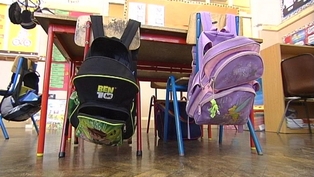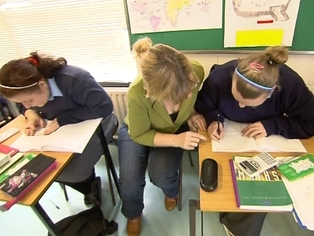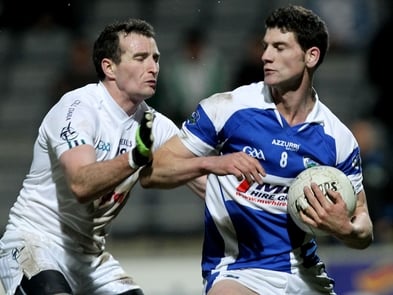Full version appeared in Laois Nationalist 12 July 2011
In 2008 economist David McWilliams attributed one of the most fascinating published barometers of the Irish economy not to the ESRI, the Central Bank or to stockbrokers. Instead, McWilliams was of the view that if you wanted to truly understand the effects of the economic downturn on a ground level in Ireland, you should go to www.gaa.ie.
The celebrity author and broadcaster made these comments after stumbling upon the online GAA Club Transfer Index, which had noted an unusually high number of transfers out of the country to New York and London, pointing toward a return to mass emigration.
Three years on, and the index is still there for all to see, and still documenting social changes with more clarity and regularity than the ‘experts’ ever could. There is one stark difference now however. Even though the figures are somewhat higher to the 2008 trend, what was then deemed unusually high to McWilliams, appeared suspiciously low to me three weeks ago. Between 1 January and 30 June 2011, there were 34 transfers out of the county, mostly abroad. Fair enough, this is a large figure; double that for the same period in 2010. But if you had been keeping your ear to the ground of the county club scene this year, you would appreciate that there are a lot of young players unaccounted for in this figure.
So, I decided to get in contact with all 43 GAA clubs in Laois and ask the simple question, “How many players have you lost to emigration since last year’s championship?”
All those contacted were given a day or two to refer to other club members and properly account for those left, as in a brief single phone call, names can easily been omitted. The count includes all panels playing for each club, excluding the juvenile end of things.
As early as when the eighth club had responded back with a definite figure for emigration, this year’s transfer figure for the entire county was surpassed, and with 37 awaiting reply, it would soon be eclipsed. In total, 147 players have emigrated since the 2010 championship ended, leaving a huge chasm in the Laois GAA club scene. The age old traditional places for Irishmen to go in search of work were still the same- America, Australia, the UK and Canada are the most popular, but there are some unusual ones too like Den Haag.
Without doubt the worst affected club in the county is Camross. 13 players have emigrated since their final championship outing in 2010. Of that 13, 7 started last year’s senior county final. “Our situation here is very bad” admits club secretary Tim Doran. “Our club has been just decimated because of the amount of lads emigrating”. According to Tim, nearly 20 players have left Camross in the last two years.
“We are struggling badly because of it. Our senior team is depending heavily on a group of players that are fresh out of minor age group. In that respect we are all quite proud of the fact that we remain competitive at senior level”. This year they reached the semi-final of the senior league, a fantastic achievement considering their losses, but they are not the same team that once struck fear into any top Leinster opposition. In all likely-hood they will have to field one less team in the 2012 championship.
 |
| Members of the Laois Forestry Group, in Camross |
During the boom-time, the majority of the young male labour force of Camross were employed in either the construction industry or in the local saw mills. Fast forward to 2011 and there is virtually no local construction industry, which had a huge effect on the saw mills too. This left the future of a single rural generation looking very bleak. Tim certainly agrees.
“In the future? I have an awful feeling that the worst of it is still to come. We are probably going to see more lads go before we can think of any coming back to the club. And I don’t blame the lads leaving for one minute. How could you expect them to survive without money? A lot of the time still living with Mammy and Daddy? There is nothing for them here”, he said. Doran envisages that in the not too distant future, more and more clubs will have to join up in order to maintain prevent the standard of the senior championship from plummeting, citing The Harps and Rathdowney Erril as examples to follow.
In recent years, many clubs have been forced to combine forces to make up numbers in the underage football championship, owing to dwindling numbers. For example at juvenile level, The Rock, Courtwood and Emo play together under the name St. Paul’s. That’s two senior clubs and one intermediate outfit, yet they only have the numbers to enter the minor B championship. And as Courtwood club Chairman George Doyle points out “even with the three teams combined, entered in a B championship which stipulates 13 a side teams, we would only have one or two subs”. For George, the merger of smaller clubs is “inevitable”.
 |
| St Paul's U-14's |
Courtwood are to the football situation what Camross are to the hurling, if not worse, as they wouldn’t have half the pick. They will start the 2011 championship 10 men lighter than they did in 2010.
“If things continue the way they do at the moment, we will be left with a situation where any of the three clubs (St Paul’s teams) staying on their own would be completely unsustainable” said Doyle. “A lot of lads wouldn’t like the idea, and in once sense I can see where they are coming from. Personally I would hate to see the Courtwood GAA club disappear altogether. But something has to be done”.
Both Doyle and 2010 Chairman Alan O’Halloran are both avid promoters of a “Parish Championship” in addition to the club championship, similar to what happens in Kerry football. With quite a low emigration trend out of Portlaoise (lost 5 from 2010), and a high pattern for rural clubs, a parish championship might provide some competition in a county dominated by The Town. It might also ensure the standard of football doesn’t slip as numbers fall away. “Would Pat Spillane had been half as successful with Kerry had he only played club football with Templeogue? Never lining out for Kenmare parish?” asks Doyle.
Whether we would ever have been ‘blessed’ with Spillane’s TV punditry had he not benefitted from a parish championship is academic, but the thought behind the question provides genuine food for thought. Especially when you consider inter-county players like Niall Donoher that aren’t playing senior football inside the county. And were it not for the exploits of parish team Annawood in 1996 and 1997, Laois legend Fergal Byron would never have played a senior championship match.
 |
| 2003 Allstar Fergal Byron |
“We know down through the years that the County Board simply react to problems, sometimes far too late, as opposed to being proactive beforehand. So maybe this sort of idea would be best off being pursued by the players, because it is the players who will be handicapped by a drop in standard” says Alan O’Halloran.
Speaking on the issue, Laois County Board Chairman Brian Allen feels that player emigration “is becoming a huge problem”. “It is certainly a worry for the county board as it is affecting the short-term future of a lot of clubs. Hopefully, when the economic tide turns, the majority of these players will return” said Allen.
 |
| Brian Smith of Portlaoise, who has emigrated to America being presented with the u-21 trophy by Laois GAA chairman Brian Allen |
To his credit, Allen is keeping a very open mind as to the ideas of amalgamations and a parish championship, so long as the demand is there for it. “We in the county board are prepared to look at absolutely anything that would improve the situation in the county. If clubs want to amalgamate, I would suggest that they amalgamate fully though. As for a parish championship, if there is enough call and demand for it, we would definitely look at the idea and we did propose it at the start of this year. But so far nobody has come to us conveying these problems” he said.
As you would expect, clubs now feel the need to try and stem the flow of players, but as Shanahoe Chariman Karol O’Keefe explains, this is easier said than done. “Well, what can you say to a young lad to keep him here? I mean, we have a situation where one good young player is all set and ready to leave. At home, he has no job, and no income. He’s smart, he’s qualified and there are loads of opportunities for him to get work abroad. And you’re asking him to put his life on hold till the end of the championship? Why would they? What right have we to ask that of him?” said O’Keefe.
Young, talented and jobless- This seems to be the average profile of those leaving, one which O’ Dempsey’s footballer Darragh Meredith fitted perfectly before he decided to emigrate in February of this year. The former Laois under-21 player is currently working in South Korea as an English teacher, and continues to play football with Seoul Gaels.
“Initially, I must admit that it was hard to leave my home club as I have a great relationship with the manager and the whole community, but I had to think of my career” said Meredith. The former inter-county minor and u21 graduated from NUIG in 2009 with B.A. in psychology and geography, and felt he needed to leave the country in order to pursue his aspiration of becoming a teacher.
“Basically I want to become a teacher and the option I contemplated going with was to do the Hibernia Postgraduate course, which takes 18 months and costs €10,000. I'm 23 and I didn't have the money at the time, and I was already paying back a university loan so there was no hope of me staying around. And the fact that teaching jobs at home are at a premium also influenced my decision to move to Korea” he said.
“My older brother did a masters in town planning that cost him the guts on €10,000 and he has no hope of getting work in Ireland, and emigration seems like the only option for him” said Meredith, whose younger brother also lives in Australia.
When he’ll line out in a blue and yellow jersey again, Darragh is unsure.
“Initially my plan was to do one year in Korea, but right now, after four and a half months I am seriously thinking about renewing my contract with my school and staying on for year two. The cost of living, the way of life, the professionalism in my job and the chance to travel Asia and experience a whole new culture have made this place very appealing to me” says Meredith, who’s involvement in GAA hasn’t diminished since the move. “The GAA has been extremely important to me out here. Yet again it has helped me to generate a network of friends and obviously a bit of a social life too”.
As outlined before, this case study in to the situation in Laois only reflects on what has happened since the end of 2010. So just imagine what the figure would be if it included all those that emigrated since 2007? And similarly if it included all 32 counties for the last four years?
Here is the breakdown of how many players have left each club, and what are the most popular destinations.
Name of Club | Number of Players Emigrated since end of 2010 championship |
Abbeyleix | 9 |
Annanough | 1 |
Arles Kilcruise | 2 |
Arles Killeen | 1 |
Ballinakill | 5 |
Ballyfinn | 3 |
Ballylinan | 0 |
Ballypickas | 2 |
Ballyroan | 4 |
Barrowhouse | 0 |
Borris/Kilcotton | 6 |
Camross | 13 |
Castletown | 3 |
Clonad | 5 |
Clonaslee | 4 |
Clough/Ballacolla | 5 |
Colt | 3 |
Courtwood | 10 |
Crettyard | 0 |
Emo | 3 |
Graiguecullen | 2 |
Kilkaven | 4 |
Kileshin | 1 |
Kyle | 0 |
Mountmellick | 7 |
O’Dempsey’s | 3 |
Park Ratheniska | 2 |
Portarlington | 1 |
Rosenallis | 0 |
Shamrocks | 3 |
Shanahoe | 5 |
Slieve Bloom | 3 |
Spink | 3 |
Mountrath | 1 |
St Joseph’s | 6 |
Stradbally | 0 |
The Harps | 5 |
The Heath | 4 |
The Rock | 4 |
Timahoe | 3 |
Portaoise | 5 |
Rathdowney/Errill | 3 |
|
|
|
|
Where are they gone?
Destination | No of players |
Australia | 59 |
U.K | 26 |
America | 36 |
Canada | 12 |
Germany | 4 |
Africa | 3 |
Dubai | 3 |
Korea | 1 |
Holland New Zealand France | 1 1 1 |
It appears from the findings that smaller rural clubs have been hit the hardest by emigration in the county, with teams struggling badly to cope with not just emigration from last year, but from what has accumulated over the past two/three years. Speaking to club members and officials some feel their own local teams have been “decimated” and “shattered”.
The case study is the first of its kind for any GAA county, yet only takes into account those that have left since the end of 2010, leaving us to wondering of the potential total figure that has emigrated since 2007 nationwide.
Transfers out of Laois have also doubled in the past year according to figures from the GAA online transfer index. There has only been a 10 per cent increase in transfers entering the county.
Appeared in Laois Nationalist 12 July 2011.
















